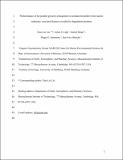Predominance of parallel glycerol arrangement in archaeal tetraethers from marine sediments: Structural features revealed from degradation products
Author(s)
Liu, Xiao-Lei; Lipp, Julius S.; Birgel, Daniel; Summons, Roger E.; Hinrichs, Kai-Uwe
DownloadAccepted version (7.576Mb)
Terms of use
Metadata
Show full item recordAbstract
© 2017 Elsevier Ltd Glycerol monobiphytanyl glycerol diethers (GMGDs) have recently been identified as degradation products of glycerol dibiphytanyl glycerol tetraethers (GDGTs) and occur as regioisomers. The distribution patterns of GMGD regioisomers are diagnostic for the glycerol configuration of their precursor GDGTs. We systematically examined the distributions of GMGDs and other regioisomer-specific degradation products in a suite of marine sediments and methane seep carbonates. The distinctly different patterns of GMGD compounds in these contrasting environments affords a new way of examining and elucidating the structures of the GDGT precursors. In contrast to the prevalent assumption of a predominant antiparallel GDGT glycerol arrangement in marine sediments, we show that the pool of GDGT-typical marine sediments, which harbor the remains of predominantly planktonic Thaumarchaeota, is composed largely of parallel regioisomers. In the contrasting environments of methane seep carbonates and Cascadia Margin subsurface sediment impacted by anaerobic methane oxidation, the patterns of the GMGD regioisomers indicate a substantial antiparallel GDGT fraction, implying that this may be a feature of methane-metabolizing Euryarchaeota. Crenarchaeol, presently considered specific to planktonic Thaumarchaeota, has an exclusively parallel glycerol arrangement with its tricyclic biphytane moiety bound to the sn3 carbon of glycerol on both sides. We provide data to show that the compound widely known as the ‘crenarchaeol regioisomer’, a compound factored into the widely used TEX86 paleotemperature proxy, rather than having an antiparallel glycerol arrangement, actually possesses a different ring configuration on its tricyclic biphytane moiety.
Date issued
2018-01Department
Massachusetts Institute of Technology. Department of Earth, Atmospheric, and Planetary SciencesJournal
Organic Geochemistry
Publisher
Elsevier BV
ISSN
0146-6380